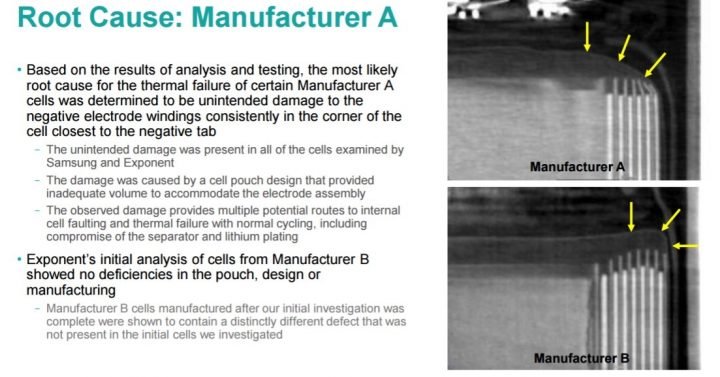it Was during the early hours of Monday, Samsung held a conference to explain the whole process of the analysis carried out in the Note 7 and present the problem that led to the withdrawal of the phablet of the south Korean company on the market. According to the obtained results, the batteries manufactured by the two companies responsible for providing the batteries to the Samsung had a defect that ended up creating a short-circuit.
there is No doubt that the Galaxy Note 7 was one of the biggest headaches that Samsung ever had to face. The explosions drove up to the that the smartphone was forbidden inside the aircraft, and forced the south Korean company, after the first collection to resolve the issue, to remove once and for all the Note 7 of the market. The following months were used to carry out the appropriate tests to try to come to a conclusion about the why of explosions present in the smartphone.
The theories were many, since the phone does not have enough space for the battery up to the fact that the batteries have a defect of manufacture. Those who bet on the second hypothesis turned out to be right, Koh Dong-jin, head of division of mobile phones from the company, explained during the conference that this explanation was "necessary to recover the confidence of consumers and partner companies". According to the results obtained, there was a manufacturing defect in the lithium batteries was that the cells negative to enter in contact with the positive, leading to a short circuit.
"In the last few months, in conjunction with independent experts of this industry, we carried out a thorough investigation to identify the cause of the problems with the Samsung Galaxy Note7". Koh stressed that, "today, more than ever, we are committed to gain the trust of the customers through innovation that redefines what is really possible in terms of security, and that opens the doors to a world of unlimited possibilities and new amazing experiences."
batteries lithium work through the cells in both positive and negative, that should not come in direct contact to not provoke a short circuit. In the first smartphones put on the market, the problem was in the format of the batteries manufactured by SDI that, as it was too small and rounded, meant that there was contact of the positive cells and negative in the upper-right corner.

the Presentation by part of the Samsung of the problems present in the upper right corner in the first models of the battery of the Note 7
In the second case, now with the batteries manufactured by ATL, the problem was in the failure of internal isolation that was that the material responsible for separating the positive cells and negative were not present or if degradasse too quickly.
the Presentation of the Samsung of the problem present on Mondays batteries present in Note 7.
During the test was built, a station for loading and unloading continues with the Note 7 to help replicate the accidents. In separate tests the company found that the problem could be the fast charging (wired and wireless) or the iris reader. None of the systems showed any abnormality or impact on the batteries.
in Addition to Samsung, also three external companies were in charge of carrying out tests to the Galaxy Note 7: the UL, the Exponent and the TUV Rheinland was responsible for the identification of the causes of the explosion. You may access a more detailed explanation here.
in order To avoid that size accident to occur, Samsung introduced a test of eight points, which will be held from here to the front in the batteries that accompany the smartphones of the brand. The eight points are:
- durability Test – will be performed multiple loads and discharges of the batteries in various controlled environments. The tests include high temperatures, high load in excess of the pressure applied;
- visual Inspection – each battery will be inspected to ensure that it meets the standards of standard;
- X-Ray – The batteries will be analyzed by an x-ray to check if all the components are in the conditions;
- Load and unload – will be carried out several cycles of charging and discharging of the batteries in normal use;
- Test TVOC – will be guaranteed by the Samsung a review to verify that there are no leaks of the internal components of the battery;
- Disassembly of batteries – some batteries will be disassembled to ensure that they are well built, including the insulating tape;
- use Test accelerated – will be held a test-intensive in that will simulate a power consumption accelerated on the devices;
- Delta Open Circuit Voltage – will be made a test to determine any change in voltage.
[See the video where is explained the eight steps of security]
These tests begin to be put into practice immediately and will be applied in all ranges of the brand, and not just in the top of the range. The company is confident that, with these eight points of security will prevent another disaster such as the Note 7, something that should have done before you put the smartphone on sale in the market.
Despite the problem being present in batteries which are manufactured by two other companies, Samsung assumes all responsibility regarding the equipment explosive. The company expects to be able to share the tests of safety, now also applied, with other companies in the market. With the launch of the Galaxy S8 for short, it remains to wait to see what arises on the part of the south Korean company that now has the chance to go back out in the mobile market.
No comments:
Post a Comment